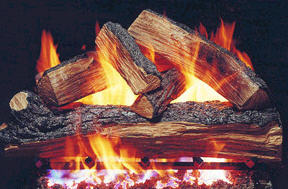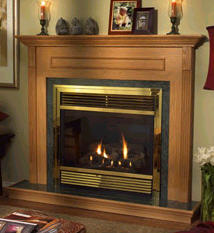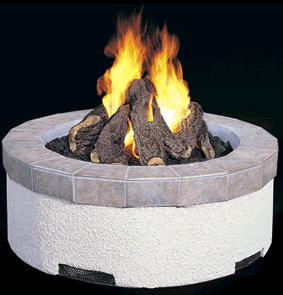Fireplace Hearth
Overview

Gas fireplaces are available as:
- retrofits to existing wood burning fireplaces
- new and retrofit vented and direct vented
- vent-free
Logs are cast from a ceramic material and painted in very realistic finishes. A combination of sand, vermiculite and rock-wool are used to produce life-like ashes.
New options include remote control.
Operation
The same gas log sets can be installed in existing fireplaces or new fireplaces manufactured for only gas logs. The older logs had only a simple on/off value and required a manual light. An inexperienced user could sometimes get a real ‘bang’ out of lighting one.
All new gas logs have a safety pilot that must be lit first, and then the main flame burner is lit from the pilot. If the pilot does not light, the gas does not come onto the main burner. New gas logs have optional remote controls for on/off and temperature and time settings.
Gas logs should be operated with a glass enclosure for the best energy efficiency.
Gas logs should be vented; non-vented units are available but are not endorsed by utility companies and may not be approved by local codes. Units can be ‘direct vent’ which vent through a sidewall rather than up a flue.
When a gas log is installed in an existing fireplace, it may be local code/practice to install a ‘clip’ on the fireplace damper to prevent it from closing completely. This is for safety so that the flame is always vented, but is bad for energy management as an open damper is a source of substantial indoor air loss, especially if there is no glass enclosure.
Operating Costs
Operating cost is a function of the size of the gas logs (BTU input rating) and the number of hours they are operated. Residential gas logs are available from about 50,000 to 150,000 BTUs. (There are larger custom made units for large fire pits like ski lodges, etc.)
If a 100,000 BTU gas log is operated for one hour, it will burn 1 CCF of natural gas and cost about $0.65 (when gas costs $0.65/CCF)
A typical fireplace may be run for a couple hours on the weekend, 3 or 4 months per year, and is therefore not a significant cost. On the other hand, a fireplace left on for supplement space heat can be VERY expensive to operate.
A gas fireplace should NOT be relied on for space heating; it is a VERY inefficient source of heat. Depending on how it is vented, and if there is a glass enclosure, the effective efficiency may be 30 to 50% at best.
More Information
For information on wood burning fireplaces and stoves see Wood Stove
Vendors and Manufacturers
 Empire Comfort Systems
Empire Comfort Systems
ECS, Inc.
918 Freeburg Avenue Belleville, IL 62222-0529
Telephone: 618-233-7420 or 800-851-3153
Go to the Empire web site at www.empirecomfort.com
 Robert H. Peterson Co.
Robert H. Peterson Co.
14724 E. Proctor Ave
City of Industry, CA 91746
Telephone: 800-332-0240
The Outdoor Campfyre is a 70,000 BTU/Hr freestanding unit
Go to the Peterson Co web site at www.rhpeterson.com
